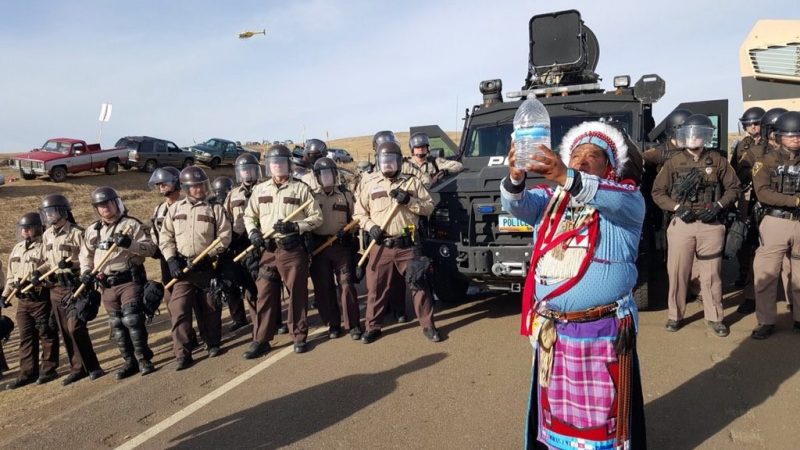Nem lehet víz nélkül élni!!
A Dakota Access Pipeline projekt (DAPL) egy olajvezeték építését tervezi. A projektet az Energy Transfer Partners valósítja meg az Egyesült Államokban, és ezekben a napokban lett véglegesítve nagy ellenállás közepette.
Az Energy Transfer Partners az olajvezeték építését munkahelyek létrehozásával, és az olaj szállításának egyszerűsödésével (kevesebb vonat és kamion) indokolja.
Az ellenállás 2014 óta folyik az olajvezeték építése ellen.
Az olajvezeték a Standing Rock nevű indián rezervátum mellett halad el, át a Missouri folyón, az Oahe tavon, és az Ogallala természetes víztározó felett. A tiltakozók felhívják a figyelmet az olajszivárgás veszélyére, amely ivóvíz-szennyezéshez vezethet, és veszélyt jelent nemcsak az emberi egészség, de az egész ökoszisztéma szempontjából is. Ezen kívül az olajvezeték építése az amerikai őslakos közösség számára fontos kulturális helyek, például történelmi temetkezése helyek, a „Sundance ünnepség helyszínei, tönkretételével is jár. Eredetileg az olajvezeték az északabbra fekvő város, Bismarck közelében haladt volna el, ez az ötlet azonban a vízszennyezés veszélye miatt el lett vetve. A tüntető amerikai őslakosok azt is hangsúlyozzák, hogy fontos ezt az ügyet az amerikai kolonializmus és a koloniális elnyomás elleni ellenállás kontextusában látni. Ezért egyenlő partnerként szeretnének részt venni a környezetüket érintő döntésekben.
A Sacred Stone sátortábort 2016. áprilisában hoztál létre a békés ellenállás jelképeként a Standing Rock rezervátum közvetlen közelében. 300 törzs állt ki a mozgalom mellett, ami az amerikai őslakos közösség elmúlt száz évének legnagyobb mozgalma lett. Ezen felül a több száz környezetvédelmi aktivista és magánszemély is részt vett a tüntetéseken, valamint 2000 veterán is eljött, hogy élő pajzsként védelmezzék a tüntetőket.
Az ellenállásnak több különböző formája volt: a sátortáboron, felvonulásokon és építési gépek munkájának akadályozásán kívül az őslakosok 2016 júliusban jogsértés megszüntetésére irányuló eljárást indítottak, a civileket és katonákat foglalkoztató szövetségi ügynökség, a U.S. Army Corps of Engineers ellen, és különböző tisztviselőkkel és szövetségi hatóságokkal találkoztak, hogy tanácskozzanak az érdekeikről. A Standing Rock fiataljai létrehozták a “Rezpect Our Water!”-kampányt, és egy petícióval kapcsolatos szolidaritási futást szerveztek, ami North Dakotából Washingtonig haladt. 2016 tavaszán a Környezetvédelmi Ügynökség (Environmental Protect Agency), a belügyminisztérium és a műemlékvédelmi hivatal is környezeti hatással kapcsolatos nyilatkozatot kért az Army of Corps-tól. Ez egy hosszabb kutatással járt volna, amely az olajvezeték lehetséges környezeti kockázatát vizsgálná. 2016-ban az ellenállás nemzetközi figyelemre tett szert, és szimpátia-tüntetések és felvonulásokat szerveztek világszerte.
December 4-én Obama elnök alatt a hadtest elrendelte az építés leállítását, hogy elkészítse a környezeti hatástanulmányt, és a vezeték alternatív útvonalait is megvizsgálják. Az új elnök, Trump azonban meghiúsította a vizsgálatot, és január 24-én aláírt egy ellentmondó utasítást az építkezés folytatására.
A tüntetők számos rendőri erőszakkal kapcsolatos esetet jelentettek. Ezen kívül Trump elnök függetlensége is megkérdőjelezhető, mert kapcsolatban áll az olajvezeték építőivel (Energy Transfer Partners). Mindez a demokrácia kérdéséhez is kapcsolódik: mennyire működik a demokrácia, és meghallgatják-e az állampolgárokat olyan kérdésekben, amelyek elengedhetetlenek a jó életminőséghez.
Location
USA, North Dakota, Sacred Stone Camp
Environmental impact
- Water pollution
- Land degradation (e.g. drought, soil contamination, erosion and desertification)
- Biodiversity loss – Ecosystem destruction
- Depletion of natural resources (fossil and mineral, forest, water, etc)
- Waste, waste disposal, and toxicants
- Alteration of landscape aesthetics and built heritage
Ethical/ legal issues
- Health and well-being
- A clean and prosperous environment and a safe and pleasant habitat
- Indigenous land, culture and rituals
- Democratic participation to decision-making on community and national affairs
Information sources & materials
Scientific/ academic books and chapters
- Duran, Bonnie; Duran, Eduardo; Yellow Horse Brave Heart, Maria (1998): Native Americans and the Trauma of History, in: Thornton, Russell (ed.): Studying Native America. Problems and Perspectives, p. 60-78.
- Churchill, Ward (2002): Struggle for the Land. Native North American Resistance to Genocide, Ecocide and Colonialism, City Lights, San Francisco. (The first chapters are available here. Last access: 22.02.2017).
Online books and newspaper, magazine, encyclopedia, or blog articles
- Aisch, Gregor; Lai, Rebecca K. K. (07.02.2017): The Conflicts Along 1,172 Miles of the Dakota Access Pipeline, The New York Times (last access: 24.02.2017).
- Allard, Ladonna Bravebull (03.09.2016): Why the Founder of Standing Rock Sioux Camp Can’t Forget the Whitestone Massacre, Yes! Magazine (last access: 24.02.2017).
- BBC News (07.02.2017): Dakota Pipeline: What’s behind the controversy? (last access: 22.02.2017).
- BBC News (02.11.2016) What is Standing Rock and why are 1.4m ’checking in’ there? (last access: 22.02.2017).
- Garcia, Feliks (03.12.2016): Dakota Access Pipeline: Department of Justice to send peacekeepers to Standing Rock as police escalate, Independent (last access: 24.02.2017).
- Hayes Kelly (29.10.2016): Remember this when you talk about Standing Rock, Yes! Magazine (last access: 22.02.2017).
- Huffington Post (09.02.2017): Construction Begins On Final Section Of The Dakota Access Pipeline. Native Americans who object to the project are still fighting it in court (last access: 22.02.2017).
- Medina, Daniel A.; Sottile, Chiara (04.12.2016): Reprieve for Native Tribes as Army Denies Dakota Pipeline Permit, NBC News (last access: 24.02.2017).
- Milman, Oliver (26.10.2016): Dakota Access pipeline company and Donald Trump have close financial ties, The Guardian, (last access: 24.02.2017).
- Indian Country Media Network (28.04.2016): Dakota Access Pipeline: Three Federal Agencies Side With Standing Rock Sioux, Demand Review (last access: 24.02.2017).
Legal & public policy reports and documents
- Great Lakes Commission (20.02.2015): Crude Oil Transport: Risks and Impacts (last access: 22.02.2017).
- Standing Rock Sioux Tribe (27.07.2016): Complaint for declaratory and injunctive relief (last access: 24.02.2017).
Social Media exchange
- Chow, Lorraine (19.12.2016): Massive North Dakota oil spill still not cleaned up 3 years later, Eco Watch (last access: 22.02.2017).
- Joseph, George (30.11.2016): 30 Years of Oil and Gas Pipeline Accidents, Mapped. The sheer number of incidents involving America’s fossil fuel infrastructure suggests environmental concerns should go beyond Standing Rock, Citylab (last access: 22.02.2017).
- https://twitter.com/hashtag/nodapl
Other Sources & Materials
- Homepage of the Camp of the Sacred Stones: Dakota Access Pipeline (last access: 22.02.2017).
- Dakota Access Pipeline Facts (last access: 22.02.2017).
- http://rezpectourwater.com/
- Standing Rock: Background on the Dakota Access Pipeline Review (last access: 24.02.2017).
Contributor(s)
Lisa Jürgens, elephantlisa@gmail.com, B.A. in Cultural Anthropology, Internship at Artemisszió Foundation, Hungary



Home › Forums › You can not live without water!!